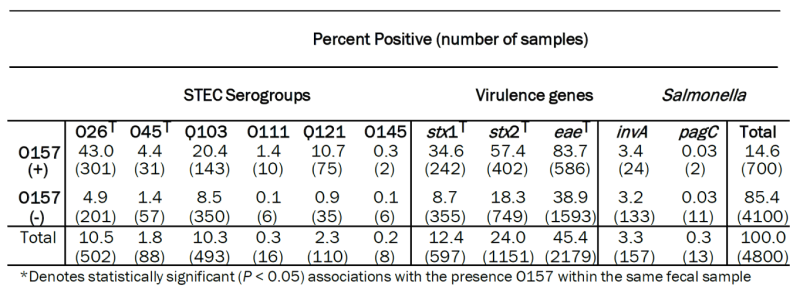Project Summary
Do Pre-harvest Interventions Intended for E. coli O157:H7 Affect Fecal Shedding of Non-O157 STEC or Salmonella in Feedlot Cattle?
- Principle Investigator(s):
- D. G. Renter
- Institution(s):
- Kansas State University
- Completion Date:
- May 2013
Background
Shiga toxin-producing Escherichia coli (STEC) and Salmonella are food safety issues that can have significant negative ramifications for the beef industry. Recently, the US Department of Agriculture, Food Safety and Inspection Service (FSIS) declared six non-O157 STEC serogroups as adulterants in ground meat and non-intact beef products, which is extremely concerning given the tremendous gaps in scientific knowledge. In recent years, there is also growing concern regarding Salmonella in beef production systems. If beef producers are to integrate pre-harvest interventions for controlling STEC and/or Salmonella, there is a need to determine the efficacy of interventions and whether there are any unintended consequences (positive or negative) when used in commercial production systems.
The objectives of the current research were to: 1) determine whether commercially available pre-harvest interventions (vaccine and direct-fed microbial) that were used to reduce STEC O157 in feces of feedlot cattle had any effects on fecal shedding of non-O157 STEC (O26, O45, O103, O111, O121, O145) or Salmonella, and 2) determine if the presence of STEC O serogroup-specific genes within a cattle fecal sample was associated (decrease, increase or no difference) with the presence of other STEC O serogroups or Salmonella within the cattle feces.
Methodology
The researchers of this study previously completed a field study that tested the efficacy of two interventions for controlling STEC O157 fecal shedding in large pens of commercial feedlot cattle. More than 17,000 cattle in 40 pens were randomized to receive one, both or neither (control) of the two interventions: a siderophore receptor and porin (SRP) proteins-based vaccine (E. coli SRP® vaccine) and a direct-fed microbial product (DFM; Bovamine®). Cattle in the vaccinated group received one dose (2 mL, SC) at enrollment and again three weeks later. The DFM was fed (106 CFU/steer/day) throughout the study period (mean = 87 days). Fresh fecal samples (30/pen) were collected weekly from pen floors for four consecutive weeks prior to the projected study end. The DNA extracted from samples (n = 4,800) were tested for STEC serogroup genes (O157, O26, O45, O103, O111, O121, and O145) and four major STEC virulence genes (stx1, stx2, eae, and ehxA) by an 11-gene multiplex PCR. In addition, a duplex real-time PCR assay for detecting invA and pagC genes was utilized for Salmonella detection. Generalized linear mixed models (GLMM) were used to analyze effects of treatments while accounting for allocation of pens within blocks and repeated measures on pens (within blocks) over time. In addition, GLMM were used to conduct within sample comparisons of presence of O serogroup and Salmonella genes.
Findings
Cumulative prevalence of STEC O serogroup and virulence genes ranged from 0.2 to 45.4%. For Salmonella, 3.3% of samples tested positive for the invA gene, 0.3% to the pagC gene, 0.1% to both (invA and pagC) and 3.4% to at least one gene (invA and/or pagC). The SRP vaccine and/or the DFM had no significant effects on fecal prevalence of the six non-O157 STEC serogroups or Salmonella (all P values were > 0.1). Within sample comparisons of presence of O serogroup, genes indicated that the presence of E. coli O157 was positively associated (all P values < 0.05) with the presence of STEC O26, O45, O103 and O121 genes in feces from feedlot cattle (Table 1). However, the presence of STEC O157 and Salmonella (invA and/or pagC genes) in a sample was not significantly associated (P > 0.05) (Table 1).
Implications
The beef industry has implemented intervention strategies in harvest facilities that have reduced the likelihood of carcass contamination with STEC, Salmonella and other potential foodborne pathogens. However, the ultimate source of these pathogens is the live animal and associated production environment. Thus, the use of pre-harvest strategies to control of pathogen loads in animals presented for harvest could have direct impact on beef safety. If beef producers are to adopt pre-harvest interventions for STEC and/or Salmonella, more data are needed to determine which interventions are the most efficacious and whether there are any unintended consequences when applied in a commercial production system. This study demonstrated that two commercially available pre-harvest interventions – the SRP® O157 vaccine and low-dose Bovamine® – did not reduce fecal shedding of non-O157 STEC serogroups or Salmonella. This is despite the fact that the vaccine was efficacious in reducing STEC O157 shedding. Observed associations between the presence of different STEC serogroups within the same cattle fecal samples may suggest that common mechanisms affecting shedding of multiple STEC may be identified as potential control points. Further understanding of how animal management strategies affect beef safety risks is essential for effective food safety risk management in the industry and improved consumer confidence in beef.
Graphs/Tables
Table 1. The percent (and number) of samples positive for STEC O-serogroups, STEC virulence genes (stx1, stx2 and eae) and Salmonella genes (invA and pagC) based on whether samples were positive (+) or negative (-) for STEC O157.
